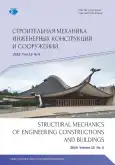Comparative analysis of the results of determining the parameters of the stress-strain state of equal slope shell
- Авторлар: Ivanov V.N.1, Alyoshina O.O.1
-
Мекемелер:
- Peoples’ Friendship University of Russia (RUDN University)
- Шығарылым: Том 15, № 5 (2019)
- Беттер: 374-383
- Бөлім: Numerical methods of structures’ analysis
- URL: https://journal-vniispk.ru/1815-5235/article/view/346292
- DOI: https://doi.org/10.22363/1815-5235-2019-15-5-374-383
- ID: 346292
Дәйексөз келтіру
Толық мәтін
Аннотация
Relevance. Thin-walled structures of shells constitute a large class in architecture, in civil and industrial construction, mechanical engineering and instrument making, aircraft, rocket and shipbuilding, etc. Each surface has certain ad-vantages over the other. So the torso surface can be deployed on the plane of all its points without folds and breaks, with the length of the curves and the angles between any curves belonging to the surface, do not change. The investigation of the stressstrain state of the equal slope shell with a director ellipse at the base is presented to date in a small volume. The aim of the work. Obtaining data for comparative analysis of the results of the stress-strain state of equal slope shells by the finite element method and the variational-difference method. Methods. To assess the stressstrain state of the equal slope shell, the SCAD Office computer complex based on the finite element method and the “PLATEVRM” program, written on the basis of the variational-difference method, are used. Results. The numerical results of the stress-strain state of the equal slope shell are obtained and analyzed, the pros and cons of the results of calculations by the finite element method and the variational-difference method are revealed.
Авторлар туралы
Vyacheslav Ivanov
Peoples’ Friendship University of Russia (RUDN University)
Хат алмасуға жауапты Автор.
Email: xiaofeng@yandex.ru
SPIN-код: 3110-9909
Engineer, Ph.D. Student, Department of Civil Engineering, Engineering Academy
6 Miklukho-Maklaya St., Moscow, 117198, Russian FederationOlga Alyoshina
Peoples’ Friendship University of Russia (RUDN University)
Email: xiaofeng@yandex.ru
SPIN-код: 8550-4986
Doctor of Technical Sciences, Professor of the Department of Civil Engineering, Engineering Academy
6 Miklukho-Maklaya St., Moscow, 117198, Russian FederationӘдебиет тізімі
- Krivoshapko S.N. (2009). Geometry of Ruled Surfaces with Cuspidal Edge and Linear Theory of Analysis of Tangential Developable Shells: Monograph. Moscow: RUDN Publ. (In Russ.)
- Ivanov V.N. (2007). The Basis of Numerical Methods of Analysis of Structures. Мoscow: RUDN Publ. (In Russ.)
- Krivoshapko S.N., Christian A. Bock Hyeng, Mamieva I.A. (2014). Chronology of erection of the earliest reinforced concrete shells. International Journal of Research and Reviews in Applied Sciences, 18(2), 95–108.
- Krivoshapko S.N., Pyatikrestovskiy K.P. (2014). On history of building of wooden shells and their opportunities at present and in the future. Structural Mechanics of Engineering Constructions and Buildings, (1), 3–18. (In Russ.)
- Krivoshapko S.N. (2018). The perspectives of application of thin-walled plastic and composite polymer shells in civil and industrial architecture. Journal of Reinforced Plastics and Composites, 37(4), 217–229. doi: 10.1177/0731684417740770
- Ivanov V.N., Romanova V.A. (2016). Konstruktsionnye formy prostranstvennykh konstruktsiy (vizualizatsiya poverkhnostey v sistemakh MathCAD, AutoCAD) [Constructive Forms of Spatial Structures (Visualization of Surfaces in MathCAD, AutoCAD)]. Moscow, ASV Publ. (In Russ.)
- Cajamarca-Zúñiga D., Alyoshina O. (2019). Análisis estructural numérico del modelo a escala 1:10 del cascarón no-canónico “Yasuní” generado sobre la base de la arquitectura biónica. Killkana Tecnica, 3(1), 7–12. doi: 10.26871/killkana_tecnica.v3i1.414. http://killkana.ucacue. edu.ec/index.php/killkana_tecnico/article/view/414
- Agapov V.P. (2004). Finite Element Method in Statics, Dynamics, and Stability of Structures. Мoscow: ASV Publ. (In Russ.)
- Ivanov V.N. (2008). The Basis of Finite Element Method and Variational-Difference Energy Method. Мoscow: RUDN Publ. (In Russ.)
- Karpilovskyy V.S., Kryksunov E.Z., Maliarenko A.A., Perelmuter A.V., Perelmuter M.A., Fialko S.Y. (2015). SCAD Office. V. 21. System Scad++. Moscow, SCAD Office Publ.
- Szmelter J., Dacko M., Dobrocinski S., Wieczorek M. (1986). Metoda elementow skonczonych w statyce konstrukcij [FEM in Statics of Buildings]. Мoscow: Stroyizdat Publ. (In Russ.)
- Perelmuter A.V., Slivker V.I. (2011). Raschetnie modeli soorujeniy i vozmozhnost ih analiza [Calculation models of structures and possibility of their analysis]. Мoscow: SCAD SOFT Publ. (In Russ.)
- Ivanov V.N. (2003). Variational-difference method and global elements in the calculation of the mates of the compartments of the shells. Structural Mechanics of Engineering Constructions and Buildings, (12), 34–41. (In Russ.)
- Alyoshina O.O. (2019). Investigation of the geometry and calculation of equal slope shells. Structural Mechanics of Engineering Constructions and Buildings, (3), 63–70. (In Russ.)
- Krivoshapko S.N., Krutov A.V. (2001). Cuspidal edges, lines of division and self-intersection of some technological surfaces of slope. RUDN Journal of Engineering Researches, (1), 98–104. (In Russ.)
- Romanova V.A., Thoma Anamariya. (2017). Automatic modeling of the surfaces of the equal slope in AutoCAD system through language AutoLISP. Structural Mechanics of Engineering Constructions and Buildings, (5), 5–11. (In Russ.)
- Romanova V.A., Rynkovskaya M., Ivanov V. (2019). Automatic modeling of surfaces with identical slopes. Advanced Structured Materials, 92, 143–156.
- Kartashev A.I. (1954). Equal Slope Surfaces (Dissertation Abstract of Candidate of Technical Sciences). Leningrad: LIIZhT Publ. (In Russ.)
- Krivoshapko S.N., Timoshin М.А. (2008). Static analysis of a torse shell of equal slope with a director ellipse. Structural Mechanics of Engineering Constructions and Buildings, (1), 3–10. (In Russ.)
- Timoshin М.А. (2008). Numerical results of the strength and buckling static analysis three shells of zero gauss curvature with a director ellipse. Injenernie Systemi – 2008: trudi Vseross. nauchno-pract. conf. (Moscow, April 7–11, 2008) (pp. 209–212). Мoscow: RUDN Publ. (In Russ.)
Қосымша файлдар









